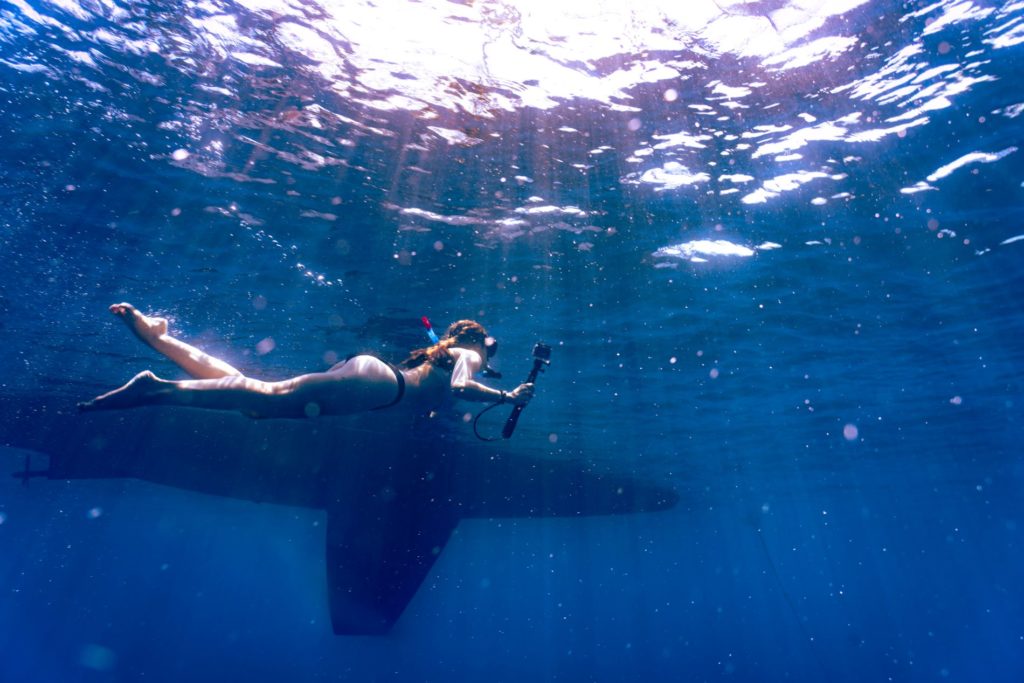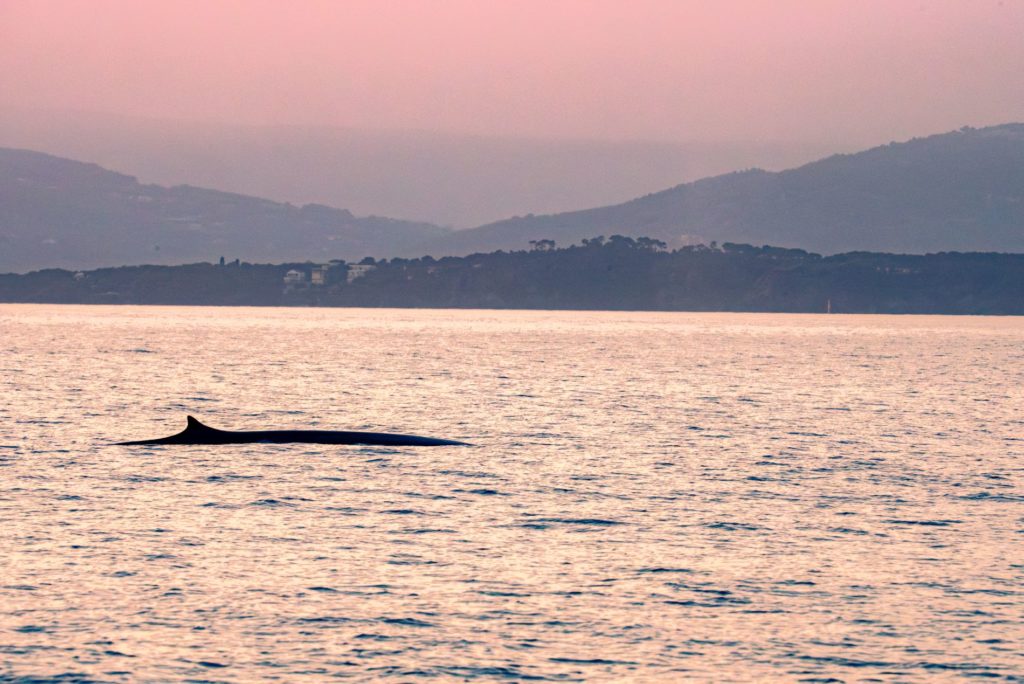A sanctuary that isn’t
For 25 years, the Swiss Cetacean Society has been working to preserve cetaceans through scientific expeditions at sea and awareness-raising campaigns in Switzerland. Our team of reporters boarded their Feeling 416 in the Mediterranean, off Les Embiez, where eco-volunteers are trying to learn more about the impact of human activity on the lives of mammals.
Text: Christopher Shand
“Look over there! A breath!” That’s the signal. The deck is abuzz with excitement. Some pointed to the north-west, while Gilles, a captain well versed in such missions, luffed up and kept his cool. Then nothing, just silent waiting. The beast’s breath has disappeared, but the fever is still there, making our eyes squint into the sun-dappled distance. Then suddenly a breath, then a second, and then another, sprays of water betraying their glittering dust above the azure immensity. With each new plume, we correct our course, gradually approaching the mammals, which we can only guess are huge. Maude and Aurélie’s excitement is palpable. The two eco-volunteers have signed up for the week with the Swiss Cetacean Society (SCS), keen to advance the science and protection of marine mammals. Charlotte and Jodie, the two passionate volunteer guides, scan the scene through their lenses, spotting two 20-metre rorquals. A common dolphin appears in front of the bow, showing off its yellow plastron as it twirls under the bow. Other stenellae coeruleoalbae – or blue-and-white dolphins – dart gently around two huge foaming footprints: where, with a final stroke of their flukes after filling their lungs with oxygen, the whales have just sounded and disappeared into the depths. Barely holding back her emotion, Charlotte explains: “It’s just incredible. The common dolphin has long been threatened with extinction. And here we have an individual in the presence of two fin whales. It’s just crazy!”

Collecting data
It’s August 1, 15 miles from the island of Les Embiez, known as Paul Ricard, on the edge of the Pelagos Triangle. Bounded by the Côte d’Azur, Monaco, Liguria, Corsica and northern Sardinia, the 87,500 km2 area was declared a sanctuary for marine mammals following the signing of a 1999 agreement between the bordering countries. The area has been classified as a “Specially Protected Area of Mediterranean Importance” (SPAMI). But in the absence of its own resources or ad hoc regulations, this means little. This is where the role of organizations such as the SCS comes into its own. Founded in 1997 by Max Olivier Bourcoud, a marine biology and conservation enthusiast who teaches in the canton of Vaud, this structure organizes worldwide campaigns to acquire data on cetacean populations. Every year, crews of eco-volunteers and specialized naturalist supervisors join forces on specially chartered sailing boats or research platforms. Co-funded by the Swiss public, these programs collect data which is then passed on to scientific partners, including the ÉcoOcéan Institut in Montpellier, for processing and use.

Maritime traffic in question
Everyone is free to join the ranks of the Lausanne-based institution in the field, and the participation of eco-volunteers remains essential to its financial autonomy. For the organization does not hesitate to tackle delicate issues. Ashore, in front of a full house at the new harbour master’s office at Les Embiez, the two guides present their work to raise awareness among boaters. The Impact-CET project, in particular, aims to map human activities at sea and estimate their potential impact on cetaceans, turtles and seabirds. This data is then provided to decision-makers to encourage them to find solutions for the management and conservation of marine fauna. The audience marvels at Charlotte and Jodie’s anecdotes. One is a marine biologist with a thesis project on humpback whales, while the other is finishing her bachelor’s degree in biology-ethnology in Neuchâtel. But the blow comes when there’s mention of the injuries caused to whales by regular ferry services. “Probability calculations lead to an annual number of 3168 potential collisions for fin whales and 297 for sperm whales”, says the EcoOcean Institut. Ferries and cargo ships are the main cause of death for fin whales and sperm whales, together accounting for 80% of collisions recorded. And yet, it wouldn’t take much to prevent this. Vanguards at the outposts, thermal detectors, communications between ships, but above all the consent of company managers to ensure that boat trajectories and speeds are adjusted in real time to the presence of whales, which must necessarily come to the surface to rest and breathe. It can take as little as 30 meters to get away from sperm whales and rorqual whales, whose presence between mainland France and Corsica correlates with that of commercial lines. Added to the problem of maritime traffic are industrial fishing and its so-called “by-catch”, of which tens of thousands of dolphins, porpoises and turtles bear the brunt every year, and floating and stranded micro- and macro-plastics whose permanent poisoning or deceptive ubiquity disfigures, tortures or tears animals to shreds. These are thoughts that our shipmates are probably mulling over. But now, captivated by the last glimmer of the waning daylight, the guides and eco-volunteers are on their last transect of the week, counting Scopoli’s shearwaters, storm-petrels and common terns dabbling in the hollows of the ultramarine-blue waves. Their enchantment is commensurate with the bewitching spectacle they witness, and for which the SCS has taken on the mission of safeguarding. For the many Swiss yachtsmen on the seas, “the SCS makes it a point of honour to distribute only certified information. Only a rigorous information policy will enable the public to understand the real stakes involved in conserving marine mammals and their environment”, reads their website. Marine ecology workshops at sea or on land, naturalist and cetology training courses, exhibitions and conferences: the organization’s many activities are calling you!

